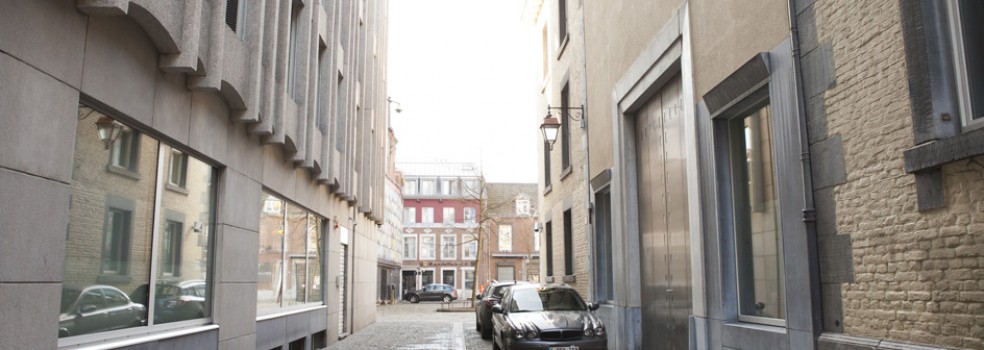At first it was a timely but unpredictable destination. You would go there on Friday or Saturday nights, or sometimes both, without any real plan, any fixed trajectory. It allowed us to temporarily escape from the quiet suburbs where we lived. A week of dull drudgery was followed by a lively weekend, in the enchantment of a club. And a real one at that. Not a ballroom or a dance hall. Not some suburban cabaret. But a club—both literally and figuratively—where you could wander about or settle into a spot and stay for hours under the magic of artificial lights, like on some soft drug for the senses.
La Chapelle was found on the ground floor of a charmless cement building that housed a car park on the floors above. It was on the corner of the Place Saint Denis in Liege. You could get to it from the narrow street Rue Sainte-Aldegonde where you could also find a flophouse and an underground hair salon. Just next to the club was a depressingly common café whose name I’ve forgotten, where they served beer with sweet, bright red grenadine in it. At nightfall the neighborhood was notorious for the fights that would break out there quite often in the late hours.
It wasn’t enough to just show up. You still had to get in. For that to happen, you had to show the bouncer, Désiré, you weren’t going to be any trouble. He was a huge black guy who worked the door like a zealous guard dog, however courteous he was. Once you got inside, you had to follow the code of proper conduct and not stray far from the rules. We always did our best to comply. As it grew late, the clientele would change. The sweet young things would head home while oddly named night owls took over the dance floor. There were locals. One guy who did his hair up in the style of Phil Oakey, It wasn’t enough to just show up. You still had to get in.
the singer for The Human League, would sway his hips while throwing his arms up to the sky. There were two brothers who we called the elephants and who always looked as if they were bored stiff. There was also a couple where the girl, always donning a hat, would dance like a sea lion and the boyfriend was a tall, frail and rather foppish guy named Jonat. These characters did not just frequent the place: they literally lived there.
Occupied by these frivolous escapes, I, in truth, hardly paid any attention to the first concerts that were held in La Chapelle at the beginning of the 80s. When looking at its program so many years back now, you realize that it fit perfectly with the period, going along with the trends while also foreseeing the successes to come. Despite its modest size, La Chapelle booked bands like Madness, Orchestral Manoeuvres in the Dark, The Beat as well as Simple Minds, all the groups that achieved fame later on. Along with those bands, it put on shows by musicians that attracted a more mature audience, such as Peter Hammill who played there several times. For a large part of its existence, the venue also hosted a large number of Belgian groups: Jo Lemaire & Flouze, Allez Allez, Polyphonic Size, The Scabs, T.C. Matic, Marine, Front 242, The Neon Judgment and many more…
While in business for nearly two decades before closing, La Chapelle was always a club first and a concert venue second. When you went there to attend a concert, it was more often on a weekday night or on a Sunday so that the shows didn’t interfere with its primary function that stretched over the whole weekend. Some reassuring aura pervaded the place. You had the comforting impression that you were sheltered from the outside world there. Was it perhaps the effect of the soothing, well-balanced lighting or of walking over the old wooden floorboards? Bernard Dobbeleer, the establishment’s iconic DJ, was of one the few ones—or the only significant one—in Liege to put on searching, audacious sounds. He played sets, one after the other, with intensity just until dawn, followed even by the elephant brothers who watched the dance floor with interest, waiting for who knows what.
One Sunday in October of 1993, returning home from a trip to Greece, I found a message on my answering machine telling me to come to La Chapelle on Thursday. The Buzzcocks were playing there and I was to go and chat with Pete Shelley or, alternatively, with Steve Diggle. I was unsure of the situation, doubting the value of the questions I was going to ask them. The weather changed abruptly that week, going from a kind of Indian summer to the first of autumn frosts. I saw it as a harbinger. In front of a small audience, the band delivered a confident show where they were ready and willing to play, but it lacked any real magic. Their repertoire came straight out of the period on the edge of the 70s/80s. The rest of it—their expressions, their gestures, their stage presence—was just a rehashing of worn-out moves that I knew only too well.
In the backstage area in La Chapelle—a long room that had been reduced to its simplest form—where I had met the band, I was given a lukewarm Jupiler. We started talking and it quickly led to a discussion on the subject of Belgian beer. The subject was harmless and innocent, keeping us from having to go into depth about anything. Shelley reminded me that The Buzzcocks had been punks before The Clash. When I asked him about the difficulty of being and having been, he responded to me with a parable: Jesus Christ had to carry his own cross. That simple analogy enabled me to understand his side of things.
Eric Therer
